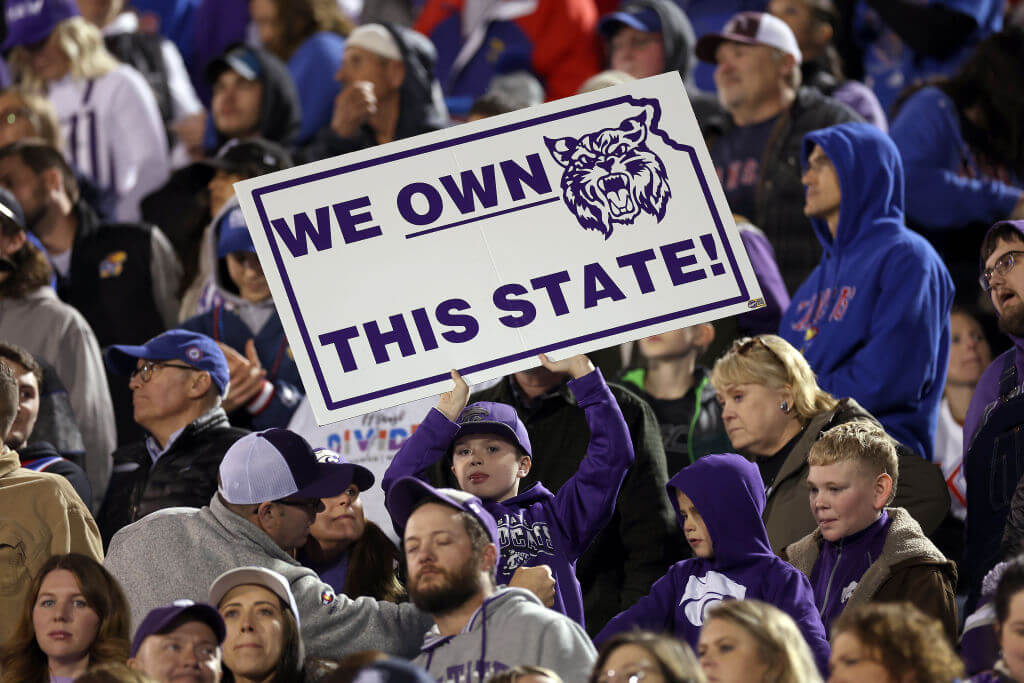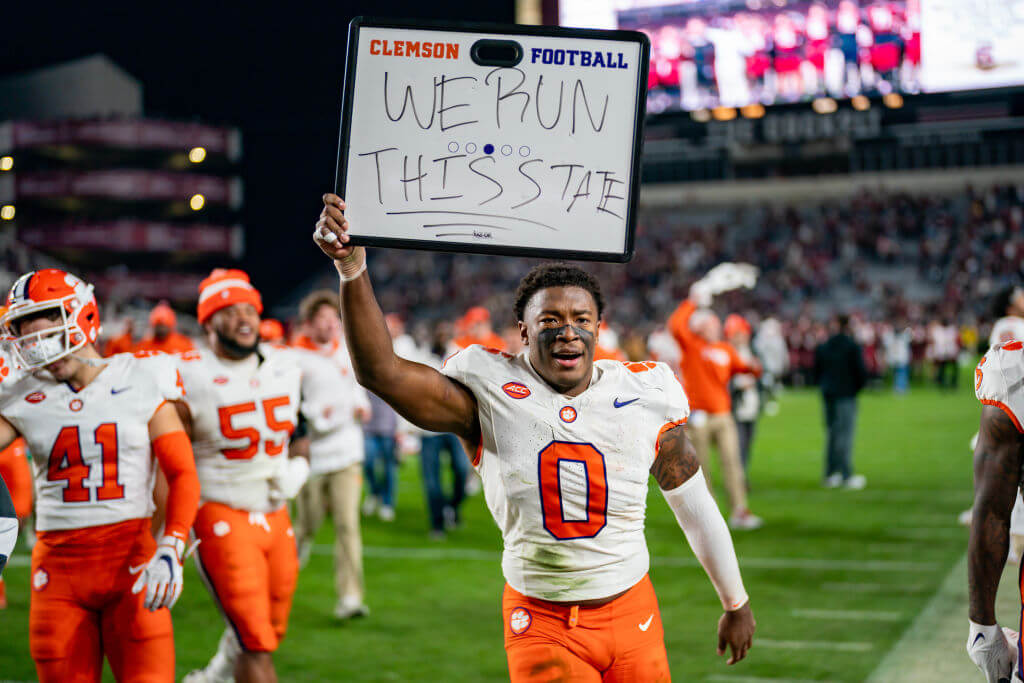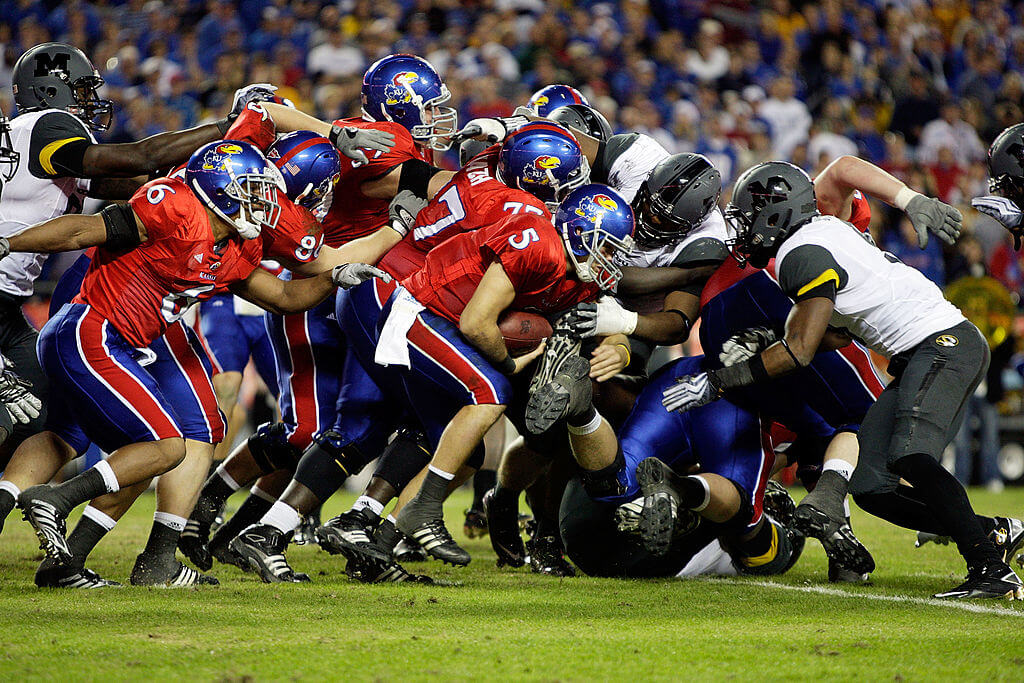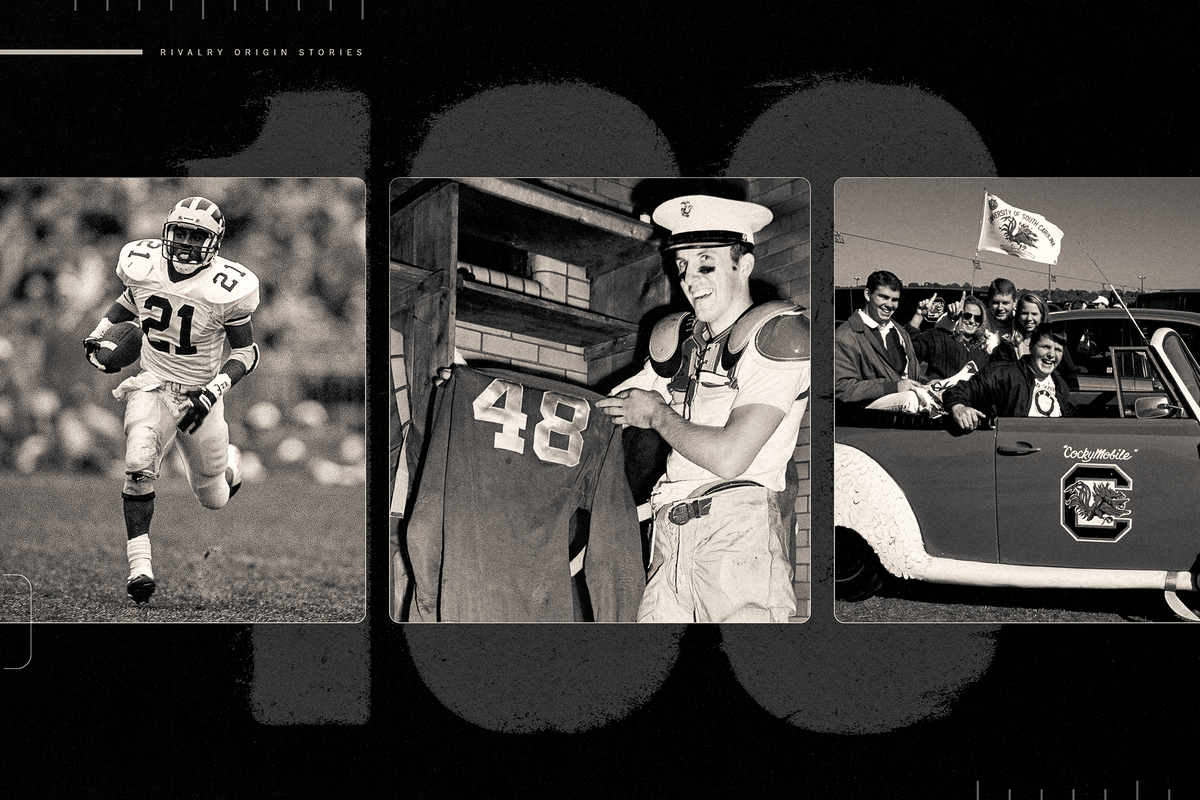Editor’s note: All week, The Athletic is writing about college football rivalries at a moment of change in the sport. Read our ranking of the top 100 rivalries here and also vote for your favorites.
Rivalries are the lifeblood of college football. They built the sport into what it is today.
But their history is often inextricably intertwined with the history of our nation. Wars, brawls, land disputes, hate and politics colored the earliest days of the sport’s most heated rivalries.
College football history is American history.
What are the wildest origin stories among college football’s rivalries?
We ranked the top 10, with a couple of extras.
10. Virginia-Virginia Tech: A battle over allegations of ineligibility
Think college football players stick around the sport too long now?
Hunter Carpenter joined the Virginia Tech football team in 1899 and played seven college seasons (six for Tech). Reportedly fueled by a desire to beat Virginia, Carpenter was named Hokies team captain in 1902.
After another rivalry loss in 1903 dropped him to 0-5, Carpenter left Virginia Tech and played for Virginia’s other rival — North Carolina — in 1904.
“I want to help Carolina beat the University of Virginia,” he reportedly said.
The Tar Heels lost 12-11 to Virginia in the 1904 season finale.
In 1905, he returned to Virginia Tech and prepared to face off against Virginia. Ahead of the game, Virginia’s student paper accused Carpenter of being a paid professional player. Carpenter and other players reportedly signed affidavits affirming their amateurism, and the star halfback helped Virginia Tech race to an 11-0 lead. He was ejected during the game — some reports say he threw a football at an opponent, others say he threw a punch — but earned his long-coveted win over the Cavaliers as neither side scored the rest of the game.
The two rivals refused to play again for 18 more years after the controversial result, but have played 96 times in the last 102 years, with the Hokies pulling ahead 62-38-5 in the all-time matchup.
9. Notre Dame-Navy: A partnership born from goodwill
Notre Dame has a host of rivals, but its most sacred is Navy. The two played every season from 1927 to 2019, interrupted only by the COVID-19 pandemic. Why?
Then an all-male university, Notre Dame faced steep financial difficulties amid World War II, mostly due to a decline in enrollment as young men enlisted for the war effort.
Navy arranged for Notre Dame’s campus to serve as a training center for V-12 candidates, an academic program built to identify and train future officers in the Navy. In 1944, more than half of Notre Dame’s students were in the military, and the university trained nearly 12,000 naval officers during the war, according to the school.
The Navy paid for use of the facilities and served as a bridge to keep the university operational through the war.
When the war ended, Notre Dame invited Navy to play a football game every season. While it’s a lopsided series that Notre Dame leads 81-13-1 all time, the schools are under contract through 2032. The respect runs deep where hate is shallow: In 2005, they began a tradition of standing for each other’s alma mater after the game.
8. Michigan-Notre Dame: Michigan taught Notre Dame how to play football
In 1887, Michigan had already been playing football for eight years. Two Michigan players who previously attended Notre Dame reached out with an offer to teach students at their former school about the game.
In November 1887, Michigan’s team traveled to South Bend and toured campus before offering instruction on this new game called football. The muddy, wet game was played on a sloppy field but ended with an 8-0 victory for Michigan in front of a few hundred Notre Dame students.
The Michigan team left Notre Dame’s campus “amidst rousing cheers,” Notre Dame’s student newspaper wrote, “leaving behind them a most favorable impression.” The event popularized the sport on campus, but Notre Dame didn’t log a victory in the rivalry until the ninth meeting in 1909. Michigan leads the all-time series 25-17-1, but the schools haven’t played since 2019.

A Kansas State fan holds up a sign during the Wildcats’ rivalry game against Kansas in 2023. (Jamie Squire / Getty Images)7. Kansas-Kansas State: A political battle to host the state’s flagship university
Kansas achieved statehood in 1861 and quickly had plans to establish a state university. Gov. Charles L. Robinson, a Lawrence resident, vetoed a bill that would have established KU in Manhattan. The state legislature sought to overturn the veto, but failed by two votes.
A year later, the state house passed another bill to establish the university in Manhattan, but it failed in the senate by one vote.
Finally, in 1863, a bill passed to establish an agricultural college in Manhattan rather than the “state” university. The legislature and Gov. Thomas Carney named Lawrence home to the state university as long as it could acquire $15,000 in funds and at least 40 acres to build a campus.
KU was finally established in 1865, two years after Kansas State was established when Bluemont Central College was renamed Kansas State Agricultural College.
When the two foes faced off in football almost four decades later, the bad blood was still boiling. Kansas holds a 65-52-5 all-time lead in the Sunflower Showdown, though Kansas State has won the last 16 meetings.
6. Colorado State-Wyoming: A brawl over officiating
The two border rivals met for the first time in 1899 in Laramie, Wyo. Each school provided its own official. The game ended in a Wyoming forfeit after Colorado State’s official, a CSU professor named Edward House, ruled that Wyoming official E.D. McArthur and the Cowboys refused to abide by the rules of the game. According to CSU historian John Hirn, the Wyoming crowd argued it should be second down when it would be third down, stormed the field during the game and cursed at House and CSU, waving canes and reportedly shouting “Kill the whole outfit! Mob them right here!”
As Colorado State left the field following the forfeit ruling, McArthur told Wyoming’s players to run for a touchdown on the now-vacated field, which would have given Wyoming the lead and victory.
That ignited a brawl. Colorado State’s quarterback was even struck in the head by a cane. Colorado State’s president said the two wouldn’t play again until Wyoming issued an apology, but the two met the following year, and it is now the longest-running rivalry in the Mountain West Conference (116 meetings).
As for that first game? Colorado State doesn’t recognize it in its history. Wyoming counts it as a victory.
5. Cincinnati-Miami (Ohio): Should Miami have been in Cincinnati?
John Cleves Symmes, a New Jersey delegate of the Continental Congress, was instructed by the federal government to reserve land for a university after purchasing 487 square miles of land in southwestern Ohio. The agreement was part of the Symmes Purchase in 1788.
But after revising the purchase, he sold some of the land rather than meeting the requirement for university land.
Ultimately, the Ohio General Assembly established Miami University in 1809 with a land grant. The War of 1812 slowed development, but the school began classes in 1824 in Oxford, 40 miles north of Cincinnati. That was two years after a failed effort to move the university to Cincinnati.
The University of Cincinnati, then known as Cincinnati College, was founded in 1819.
The two schools began playing football against one another in 1888, making it tied for the oldest rivalry in the Football Bowl Subdivision. The teams have met in 79 consecutive seasons, but won’t play in 2025.

Clemson holds a 73-44-4 edge over South Carolina in the Palmetto Bowl. (Jacob Kupferman / Getty Images)4. Clemson-South Carolina: Should Clemson exist?
South Carolina College was founded in 1801, but for much of the next century, there was debate about whether a separate state agricultural school should be established. After the Civil War, South Carolina College briefly desegregated, allowing Black students from 1873 to 1877, but politicians closed the university in 1877 and reopened it as an all-White school in 1880.
In the 1880s, Benjamin Tillman, a politician, White supremacist and leader of the state’s agrarian movement, campaigned for a separate land-grant college focused on agricultural studies, and pushed for South Carolina to accept plans from Thomas Green Clemson to will his estate to the state for the cause.
Clemson was founded in 1889 and a year later, Tillman won an election to become governor of the state.
The controversy that surrounded Clemson’s birth was more than enough to spawn a heated rivalry between the two schools since 1896 that has persisted despite the two never sharing a conference. In 2004, the two sides engaged in an ugly brawl with just under six minutes to play. Both teams banned themselves from bowl eligibility and handed out suspensions that carried over to the 2005 season.
3. Texas A&M-Baylor: The brawl on the Brazos
Early in the football history of both programs, Baylor and Texas A&M played multiple times per year because of the lack of regional opponents. They played thrice in 1901 and 1903 and twice in 1902, 1904 and 1905.
The rivalry was mostly built on geography. Then an incident in 1926 forced a five-year freeze and cemented the two as the bitterest of rivals.
Baylor hosted a halftime celebration during homecoming in Waco with A&M in town. As a flatbed truck carrying female Baylor students rode by, the women holding signs with scores from previous Baylor victories, a couple of Texas A&M Corps of Cadets members rushed the truck. Some Aggie accounts of the parade claimed the truck was carrying men dressed in drag. One cadet grabbed the steering wheel and the sudden movement sent a woman tumbling off the back of the truck, according to WacoHistory.org. This incited a riot almost immediately. Fans used chairs and wooden planks on the sideline as weapons. The riot reportedly ended when the Fightin’ Texas Aggie Band began playing “The Star-Spangled Banner.”
In the melee, A&M fan Charles M. Sessums suffered a fractured skull and died the next morning from a blood clot.
The exact circumstances and fuzzy details of the riot have been debated and researched for decades — including an urban legend that some cadets in College Station attempted to take a howitzer to Waco via a rail car. The two teams didn’t play again until 1931, but from there the rivals met every year (excluding a two-year hiatus during World War II) until 2011, when Texas A&M left for the SEC.
2. Michigan-Ohio State: The cold war ignited by a land feud
In 1835, Michigan applied for statehood. It did so while including a 468-square-mile territory known as the Toledo Strip, which had been under dispute because of a mistake in the earliest maps of the area around Lake Michigan.
The border dispute led to numerous lawsuits and legal conflicts. Militias formed to maintain the border, but there was little formal, violent conflict. The dispute over the Toledo Strip also forced President Andrew Jackson to act to prevent bloodshed and the loss of a political foothold in the swing state of Ohio.
Congress proposed Michigan give up the Toledo Strip to Ohio in exchange for statehood and ownership of the rest of the Upper Peninsula. It was initially rejected, but Michigan later accepted the deal after pressure from Jackson.
The dispute between the neighbors made for chilly relations that carried over into the Michigan-Ohio State rivalry, known as The Game. The two sides have met 14 times while both were ranked in the top five, including three consecutive games from 2021 to 2023. No other rivalry has more such meetings.

Kansas and Missouri will resume their football rivalry this season after a 14-year hiatus. (Jamie Squire / Getty Images)1. Kansas-Missouri: The Border War preceded by a literal border war
In the 1850s, as Kansas pursued statehood, there was a dispute about whether it would be a free or slave state. America was headed toward the Civil War and both sides knew the manpower and land would be valuable, to say nothing of the moral implications.
The debate was mostly argued via violence and guerrilla warfare between citizens of Kansas and slave state Missouri on its border. Those fighting for the free state cause became known as Jayhawkers. The small band of militia that protected Columbia, Mo., was known as the Tigers.
On Aug. 21, 1863, former Lawrence resident and advocate for the Confederacy William Quantrill led a group of about 400 men to raid Lawrence, killing over 150 men and leaving much of the city burning. It was the defining moment of the border war, also known as Quantrill’s Raid and the Lawrence Massacre. It has been depicted and referenced in numerous works of art in the 160 years since.
It ignited a rivalry that carried over into athletic competition when football began a few decades later.
Many of the characters of the time still hover in the rivalry. Some Kansas fans will wear shirts to games against Missouri that depict “Tragic Prelude,” a famous painting of abolitionist John Brown in which he holds a rifle in one hand and a Bible in the other, symbolizing the fight to keep Kansas a free state.
During a 2009 Kansas-Missouri men’s basketball game at Allen Fieldhouse, the KU student section displayed a giant, modified version of the painting, replacing the Bible in his left hand with the 2008 national championship trophy, won by the Jayhawks.
Two small-school shoutouts
Williams-Amherst: The Division III rivalry was born back in 1821 when Zephaniah Swift Moore, then-Williams president, took a selection of faculty and students and started Amherst College 60 miles away. He’d long believed Williams College’s campus was located in an area too remote and had failed to have it relocated. His solution: Make a new school closer to Boston. Thus, what became The Biggest Little Game In America was born. In 2007, Williams hosted ESPN’s “College GameDay” in Williamstown ahead of the game against Amherst.
Lehigh-Lafayette: The earliest portions of the rivalry go back to Episcopalians vs. Presbyterians. The teams first played each other in football in 1884, but in 1888, Lehigh fans reportedly burned down the makeshift bleachers at the stadium in the postgame revelry of a win (a pre-Lafayette bonfire became a Lehigh tradition). In 2014, the rivals met at Yankee Stadium in front of 48,256 fans to celebrate the 150th game in the rivalry.
(Top image: Illustration: Will Tullos / The Athletic; Photos: John Biever, Bettman, David Cruz / Getty Images)
